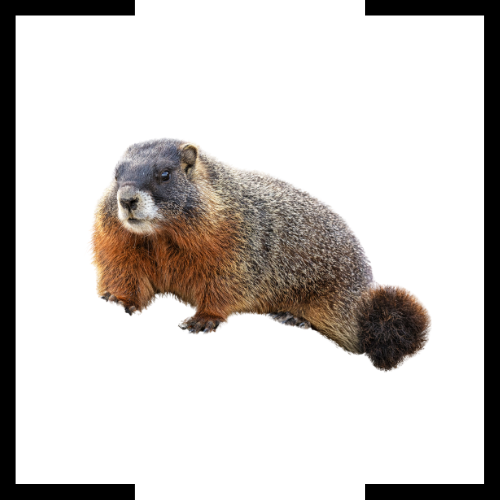Rock Chuck, also known as yellow-bellied marmots, are a common sight in the rugged landscapes of Idaho. These creatures have increasingly become a concern for homeowners and business owners across the state. They are characterized by their chunky build, brown fur, and a penchant for burrowing, which can lead to significant issues in both urban and rural settings.
Rock Chuck are known to enjoy long periods of sunbathing. They often lie on rocks, logs, or even open areas to soak up the sun, especially in the morning. This behavior not only helps them regulate their body temperature but also offers a delightful sight for nature watchers.
Unlike many other solitary rodents, Rock Chuck live in colonies and have complex social structures. They communicate through various sounds and body movements, warning each other of predators and bonding with family members.
They are one of the few animals that enter into true hibernation. They can sleep for up to 7 months without eating, surviving off their fat reserves. This remarkable adaptation allows them to thrive in environments where food is scarce during the winter.
Rock Chuck vs. Woodchuck: Understanding The Differences
While both species belong to the marmot family, there are subtle differences in their appearance. Rock Chuck tend to have a slightly lighter fur color, ranging from brown to yellowish-brown, which helps them blend into their mountainous and grassland habitats. They are robust animals with a stocky build, short legs, and a bushy tail. Woodchucks, conversely, have darker brown fur, which provides camouflage in their forest-edge habitats. They share the robust and stocky build typical of marmots but can appear slightly larger than their counterparts.
Rock Chuck are known for their social colonies. Their hibernation period in the cold mountainous regions is a critical aspect of their lifecycle, during which they retreat to their burrows for several months. Woodchucks are more solitary creatures, with less emphasis on social structures outside of the breeding season. Their hibernation is similarly essential, but woodchucks prepare for it differently, often creating a specific "winter burrow" separate from their regular living quarters.
What Draws Them To Your Home?
Homes provide several environmental features that are incredibly inviting to them. They are attracted to areas that offer protection from predators and the elements. Debris piles, unkempt shrubbery, and even crawl spaces under sheds or decks can provide the perfect shelter for them.
Gardens, lawns, and ornamental plants serve as a buffet for them. They are particularly fond of leafy greens, vegetables, and fruits, which are often plentiful in residential yards. Bird baths, leaky hoses, or pet water bowls can inadvertently provide a reliable water source them.
The presence of new, large holes around your property, especially near buildings or food sources, is a telltale sign. Gnaw marks on plants, trees, and even outdoor furniture can also indicate activity. Although they are not particularly noisy, sudden, unexplained sounds from under decks or sheds may suggest their presence. Rock Chuck visibility and activity can significantly increase with seasonal changes, particularly in spring and early summer when they emerge from hibernation and in late summer as they prepare for the next hibernation period. This is when they are most likely to venture closer to human habitats in search of food and mates.
Assessing The Risks
The likelihood of them biting humans or pets is relatively low under normal circumstances. These animals are generally more inclined to flee than fight when confronted. However, like most wild animal, they can become aggressive if cornered, threatened, or if they feel their young are in danger. In such cases, they might bite in self-defense. It's essential to treat bites from a wild animal with immediate medical attention due to the risk of infection or transmission of diseases.
Rock Chuck are carriers of several pathogens that can lead to diseases in humans and animals. One of the most notable is the bacterium that causes plague, which can be transmitted through fleas that have fed on an infected animal. While cases are rare, the possibility underscores the importance of managing populations near human habitation. Rabies, though less common in them than in other wild mammals, is another potential risk, emphasizing the need for caution and professional wildlife management.
Rock Chuck are known for their burrowing activities, which can undermine structural foundations, damage lawns and gardens, and lead to unsafe conditions on properties. The excavation of large burrow systems near or under manmade structures can compromise the stability of buildings, decks, and other outdoor features. Additionally, their appetite for vegetation can destroy landscaping, garden plants, and trees, resulting in economic losses and aesthetic damage.
Direct encounter scan lead to injuries from bites or scratches, especially if a pet tries to chase or play with one. Indirectly, the holes and burrows created by Rock Chuck pose tripping hazards and can result in injuries to pets playing or running in the yard. Furthermore, pets may be exposed to the same diseases carried by Rock Chuck, either through direct contact or via vectors like fleas and ticks.
Agricole Wildlife Solutions specializes in humane and environmentally responsible methods for managing wildlife issues, including Rock Chuck infestations. Our expertise ensures that not only are the immediate concerns addressed but also that long-term solutions are implemented to prevent future problems.
Frequently Asked Rock Chuck Questions
Q1. Can they predict the weather?
A1. While there's a popular belief in some regions that animals like groundhogs (closely related to Rock Chuck) can predict the coming of spring, there's no scientific evidence to support this idea for them or any other marmot species. The myth likely stems from their hibernation patterns, with their emergence in spring being misinterpreted as a weather prediction.
Q2. Do they have a favorite food?
A2. Rock Chuck are herbivores with a diet that varies by season. They are particularly fond of green, leafy vegetables and have been known to favor cultivated crops in gardens, such as lettuce, peas, and carrots. However, their natural diet primarily consists of grasses, flowers, and herbs found in their wild habitat.
Q3. Why do Rock Chuck whistle?
A3. Often known as "whistle pigs" due to this behavior, they whistle primarily as an alarm call to warn their colony of potential danger. This high-pitched sound can travel long distances, quickly alerting others of threats like predators. Interestingly, the specific nature or urgency of the threat can alter the frequency and duration of the whistle, making it a highly effective communication tool in their natural environment.


